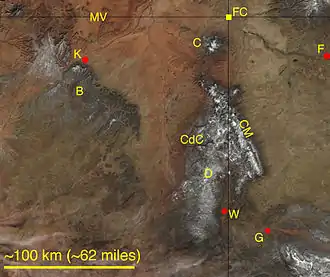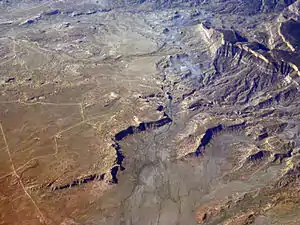Black Mesa (Apache-Navajo Counties, Arizona)
Black Mesa (also called Big Mountain) is an upland mountainous mesa of Arizona, north-trending in Navajo County, west and southeast-trending in Apache County. In Navajo it is called Dziłíjiin ('Black Mountain') and during Mexican rule of Arizona it was called Mesa de las Vacas (Spanish for 'mesa of the cows').[1] It derives its dark appearance from the numerous seams of coal that run through it.[2]

Geography
The mesa is located on the Colorado Plateau near Kayenta, Arizona, and rises to over 8168 feet. Its highest peak is located on Black Mesa's northern rim, a few miles south of the town of Kayenta. Reliable springs surfacing at several locations mean the mesa is more suitable for continuous habitation than much of the surrounding desert area. It is now split between the Hopi and Diné (Navajo) tribal reservations.[3]
Black Mesa is also the name of a small Navajo community off BIA-8066, which lies 17 miles west of Rough Rock, 20 miles north of Blue Gap and 25 miles northeast of Pinon. In the area is a local Chapter House and a community school.[4]
Mining

Since the 1960s the mesa has been strip mined for coal by the Peabody Western Coal Company, stirring a controversy over Peabody Energy's use of groundwater to transport coal.
In 2013, the Climate Justice Alliance (CJA), collaborating with the Black Mesa Water Coalition, held their first national gathering in opposition to the strip mining of the mesa. The gathering had an attendance of 100 members. [5]
References
- "The National Gazetteer of the United States of America; Arizona 1986". Professional Paper. 1987. doi:10.3133/pp1200az. ISSN 2330-7102.
- News, Sarah Donahue Cronkite. "Clean energy produced on Navajo land could help power Los Angeles". Arizona Daily Star. Retrieved 2020-03-08.
- "Black Mesa, Arizona | The Tony Hillerman Portal". ehillerman.unm.edu. Retrieved 2020-03-08.
- "Black Mesa Community School District (2020) | Pinon, AZ". www.publicschoolreview.com. Retrieved 2020-03-08.
- "First National Our Power Campaign Convening". Climate Justice Alliance. 2013-06-13. Retrieved 2020-03-08.